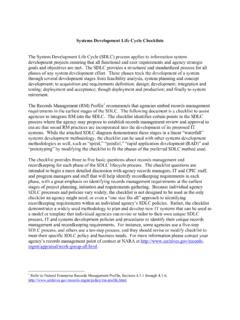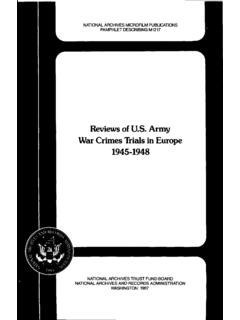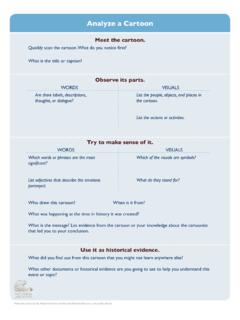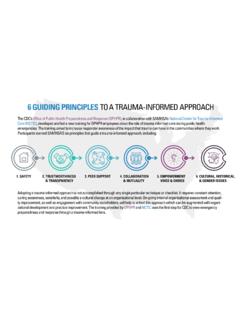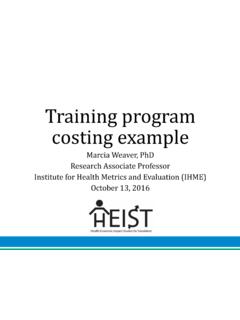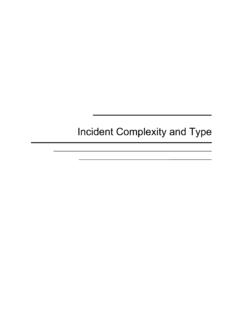Transcription of Derivative Classification Training - Archives
1 1 This document is UNCLASSIFIED. Markings are for Training purposes Classification TrainingInformation Security Oversight OfficeNational Archives and Records AdministrationAugust 20172 IntroductionOriginal Classification vs Derivative Classification Original Classification is the initial determination that information requires, in the interest of the national security, protection against unauthorized disclosure. Derivative Classification is the incorporating, paraphrasing, restating, or generating in new form information that is already classified, and marking the newly developed material consistent with the Classification markings that apply to the source Training Original Classification authorities (OCA) are required to have Training every year.
2 Derivative classifiers are required to have Training every two Order 13526, Classified National Security Information, December 29, 200932 CFR part 2001, Classified National Security Information, June 25, 2010 Marking Classified National Security Information, December 2010, Revision 3, January document is UNCLASSIFIED. Markings are for Training purposes of Derivative ClassificationAvoiding Over-ClassificationInformation SharingClassification LevelsReasons for ClassificationDuration of ClassificationProhibitions and LimitationsClassification ChallengesIdentification and MarkingsSecurity Classification GuidesSanctionsThis document is UNCLASSIFIED. Markings are for Training purposes Over-Classification5 553, Reducing Over- Classification Act, signed October 7, 2010 Legislation to decrease over- Classification and promote information sharing across the federal government and with state, local, tribal, and private sector entities.
3 Over- Classification of information causes considerable confusion regarding what information may be shared with whom, and negatively affects the dissemination of document is UNCLASSIFIED. Markings are for Training purposes to Classified Information6A person may have access to classified information provided that: a favorable determination of eligibility for access has been made by an agency head or the agency head s designee; the person has signed an approved nondisclosure agreement, SF 312 or similar document; and the person has a need-to-know the document is UNCLASSIFIED. Markings are for Training purposes 312 This document is UNCLASSIFIED. Markings are for Training purposes of ClassificationSection , 13526 Top Secret shall be applied to information, the unauthorized disclosure of which reasonably could be expected to cause exceptionally grave damage to the national security that the original Classification authority is able to identify or be applied to information, the unauthorized disclosure of which reasonably could be expected to cause serious damage to the national security that the original Classification authority is able to identify or be applied to information.
4 The unauthorized disclosure of which reasonably could be expected to cause damageto the national security that the original Classification authority is able to identify or document is UNCLASSIFIED. Markings are for Training purposes for ClassificationSection , 13526(a) Military plans, weapons systems, or operations(b) Foreign government information(c) Intelligence activities (including covert action), intelligence sources or methods, or cryptology(d) Foreign relations or foreign activities of the United States, including confidential sources(e) Scientific, technological, or economic matters relating to the national security(f) United States Government programs for safeguarding nuclear materials or facilities(g) Vulnerabilities or capabilities of systems, installations, infrastructures, projects, plans, or protection services relating to the national security(h)
5 The development, production, or use of weapons of mass destructionThis document is UNCLASSIFIED. Markings are for Training purposes of ClassificationSection , 13526At the time of original Classification , the OCA shall establish a specific date or event for declassification based on the duration of the national security sensitivity of the information. 10 years from the date of the original decision Up to 25 years from the date of origin of the documentNo information may remain classified document is UNCLASSIFIED. Markings are for Training purposes and LimitationsSection , 13526In no case shall information be classified, continue to be maintained as classified, or fail to be declassified in order to: Conceal violations of law, inefficiency, or administrative error.
6 Prevent embarrassment to a person, organization, or agency. Restrain competition. Prevent or delay the release of information that does not require protection in the interest of the national document is UNCLASSIFIED. Markings are for Training purposes Challenges12 Section , 13526(a) Authorized holders of information who, in good faith, believe that its Classification status is improper are encouraged and expected to challenge the Classification status of the information in accordance with agency procedures established under paragraph (b) of this section.(b) In accordance with implementing directives issued pursuant to this order, an agency head or senior agency official shall establish procedures under which authorized holders of information, including authorized holders outside the classifying agency, are encouraged and expected to challenge the Classification of information that they believe is improperly classified or unclassified.
7 These procedures shall ensure that:(1) individuals are not subject to retribution for bringing such actions;(2) an opportunity is provided for review by an impartial official or panel; and(3) individuals are advised of their right to appeal agency decisions to the Interagency Security Classification Appeals Panel (Panel) established by section of this order.(c) Documents required to be submitted for prepublication review or other administrative process pursuant to an approved nondisclosure agreement are not covered by this document is UNCLASSIFIED. Markings are for Training purposes Challenges1332 CFR (a) Challenging Classification . Authorized holders, including authorized holders outside the classifying agency, who want to challenge the Classification status of information shall present such challenges to an original Classification authority with jurisdiction over the formal challenge under this provision must be in writing, but need not be any more specific than to question why information is or is not classified, or is classified at a certain level.
8 (b) Agency procedures. (1) .. agencies shall ensure that no retribution is taken against any authorized holders bringing such a challenge in good faith.(2) Agencies shall establish a system for processing, tracking and recording formal Classification challenges made by authorized holders. Agencies shall consider Classification challenges separately from Freedom of Information Act or other access requests, and shall not process such challenges in turn with pending access document is UNCLASSIFIED. Markings are for Training purposes Challenges14 Considerations:Whenever an agency receives a Classification challenge to information that has been the subject of a challenge within the past two years, or that is the subject of pending litigation, the agency is not required to process the challenge beyond informing the challenger of this fact and of the challenger s appeal rights, if Classification challenge provision is not intended to prevent an authorized holder from informally questioning the Classification status of particular information.
9 Such informal inquiries should be encouraged as a means of holding down the number of formal challenges and to ensure the integrity of the Classification :The agency shall provide an initial written response to a challenge within 60 days. If the agency is unable to respond to the challenge within 60 days, the agency must acknowledge the challenge in writing, and provide a date by which the agency will respond. The acknowledgment must include a statement that if no agency response is received within 120 days, the challenger has the right to forward the challenge to the Interagency Security Classification Appeals Panel (ISCAP) for a decision. Agency responses to those challenges it denies shall include the challenger s appeal rights to the 1 Challenge submittedDay 60 Agency provides written responseDay 120If agency response not received, challenge may be forwarded to ISCAPThis document is UNCLASSIFIED.
10 Markings are for Training purposes of MarkingsMarkings identify: The information that must be protected. The level of protection that is required. The Classification authority. The reason the information is classified. The time period (or duration) for : the use of portion markings dates back to 11652, Classification and Declassification of National Security Information and Material, June 8, 1972, signed by President Richard document is UNCLASSIFIED. Markings are for Training purposes Classification Derivative Classification is the incorporating, paraphrasing, restating, or generating in new form information that is already classified, and marking the newly developed material consistent with the Classification markings that apply to the source Classification includes the Classification of information based on Classification duplication or reproduction of existing classified information is not Derivative Classified DocumentStep 1: portion markStep 2: overall Classification markingStep 3: Classification authority blockClassified By: [ Derivative classifier, by name and position, or personal identifier]Derived From: [source information]Declassify On.


